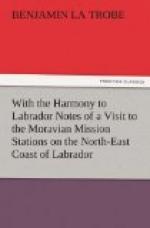But, as I said before, edification predominates, and truly it is edifying to hear the hearty singing and see the reverent demeanour of all classes of this Eskimo congregation. I may here add that after being present at between thirty or forty services at our six stations, I do not remember seeing a single boy or girl talking or laughing with a neighbour in church. Had one done so, no doubt he or she would have received a timely rebuke from some native-helper. The Eskimoes at Hopedale have been known to take the Newfoundland fishermen to task for irreverence.
FOOTNOTES:
[Footnote B: This gives me an opportunity of recording thanks to the Drummond Tract Institute for a free supply of bright Christian publications in English, which have been distributed, and will, I trust, bear some fruit. From the Religious Tract Society and other benefactors we have also received valuable help for evangelistic efforts among English-speaking sailors or settlers on the Coast of Labrador.]
WALKS IN THE NEIGHBOURHOOD OF OKAK.
The word Okak signifies “the Tongue.” The station is situated on a hilly island, which for nearly half the year is practically part of the mainland, for the broad straits are bridged by thick ice. The heights around our little settlement command fine views of the surrounding mountains and fjords. The island of Cape Mugford is one of the grandest objects in the barren landscape, and the Kaumajets, a noble range, stretch away to the north of it.
Thursday, August 30th.—Had an interesting walk over moorland in search of the site of Kivalek, one of the old heathen villages, from which the population of Okak was drawn. On a grassy plain we found the roofless remains of many turf huts. They are similar to the mounds near Hopedale, already described, but larger and more numerous. One cannot but view, with a sad interest, these remnants of the former abodes of pagans without hope and without God in the world. “Let them alone, they are very happy in their own religion.” So some would tell




